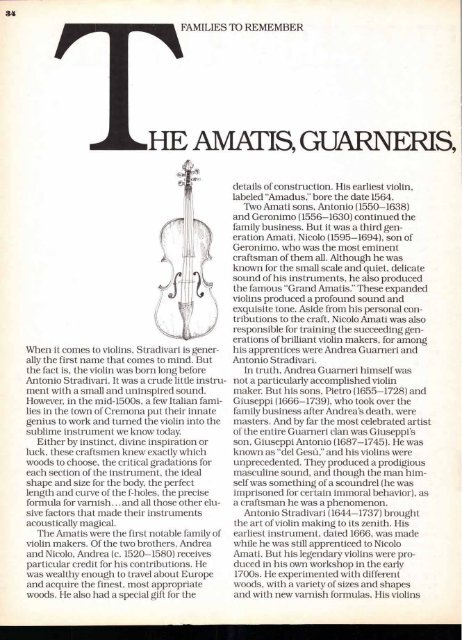Volume 12–4 (Low Res).pdf - U&lc
Volume 12–4 (Low Res).pdf - U&lc
Volume 12–4 (Low Res).pdf - U&lc
Create successful ePaper yourself
Turn your PDF publications into a flip-book with our unique Google optimized e-Paper software.
34<br />
When it comes to violins, Stradivari is generally<br />
the first name that comes to mind. But<br />
the fact is, the violin was born long before<br />
Antonio Stradivari. It was a crude little instrument<br />
with a small and uninspired sound.<br />
However, in the mid-1500s, a few Italian families<br />
in the town of Cremona put their innate<br />
genius to work and turned the violin into the<br />
sublime instrument we know today.<br />
Either by instinct, divine inspiration or<br />
luck, these craftsmen knew exactly which<br />
woods to choose, the critical gradations for<br />
each section of the instrument, the ideal<br />
shape and size for the body, the perfect<br />
length and curve of the f-holes, the precise<br />
formula for varnish... and all those other elusive<br />
factors that made their instruments<br />
acoustically magical.<br />
The Amatis were the first notable family of<br />
violin makers. Of the two brothers, Andrea<br />
and Nicolo, Andrea (c. 1520-1580) receives<br />
particular credit for his contributions. He<br />
was wealthy enough to travel about Europe<br />
and acquire the finest, most appropriate<br />
woods. He also had a special gift for the<br />
FAMILIES TO REMEMBER<br />
HE AMATIS, GUARNERIS<br />
9 9<br />
details of construction. His earliest violin,<br />
labeled "Amadus," bore the date 1564.<br />
Two Amati sons, Antonio (1550-1638)<br />
and Geronimo (1556-1630) continued the<br />
family business. But it was a third generation<br />
Amati, Nicolo (1595-1694), son of<br />
Geronimo, who was the most eminent<br />
craftsman of them all. Although he was<br />
known for the small scale and quiet, delicate<br />
sound of his instruments, he also produced<br />
the famous "Grand Amatis." These expanded<br />
violins produced a profound sound and<br />
exquisite tone. Aside from his personal contributions<br />
to the craft, Nicolo Amati was also<br />
responsible for training the succeeding generations<br />
of brilliant violin makers, for among<br />
his apprentices were Andrea Guarneri and<br />
Antonio Stradivari.<br />
In truth, Andrea Guarneri himself was<br />
not a particularly accomplished violin<br />
maker. But his sons, Pietro (1655-1728) and<br />
Giuseppi (1666-1739), who took over the<br />
family business after Andrea's death, were<br />
masters. And by far the most celebrated artist<br />
of the entire Guarneri clan was Giuseppi's<br />
son, Giuseppi Antonio (1687-1745). He was<br />
known as "del Gesu," and his violins were<br />
unprecedented. They produced a prodigious<br />
masculine sound, and though the man himself<br />
was something of a scoundrel (he was<br />
imprisoned for certain immoral behavior), as<br />
a craftsman he was a phenomenon.<br />
Antonio Stradivari (1644-1737) brought<br />
the art of violin making to its zenith. His<br />
earliest instrument, dated 1666, was made<br />
while he was still apprenticed to Nicolo<br />
Amati. But his legendary violins were produced<br />
in his own workshop in the early<br />
1700s. He experimented with different<br />
woods, with a variety of sizes and shapes<br />
and with new varnish formulas. His violins
















